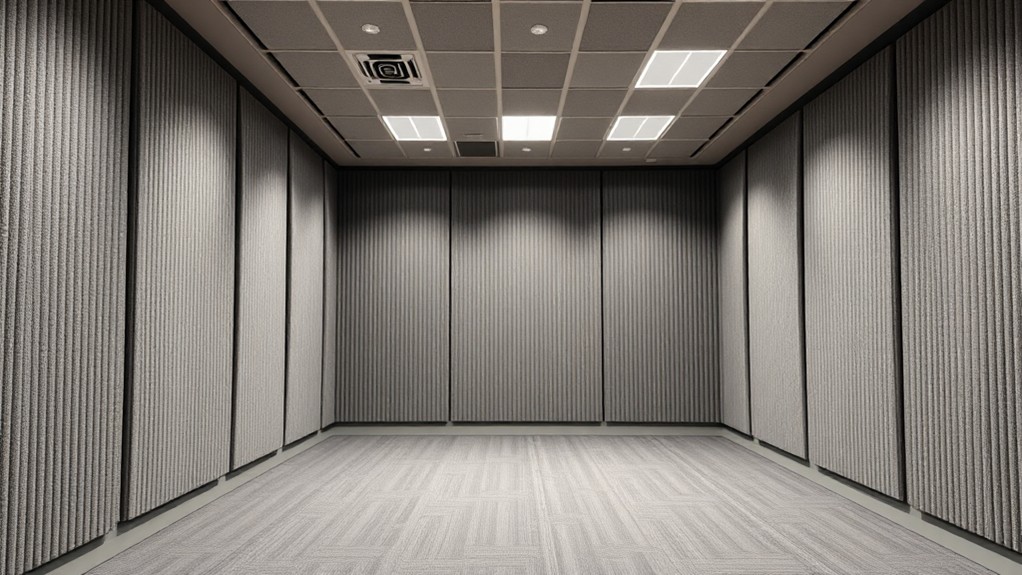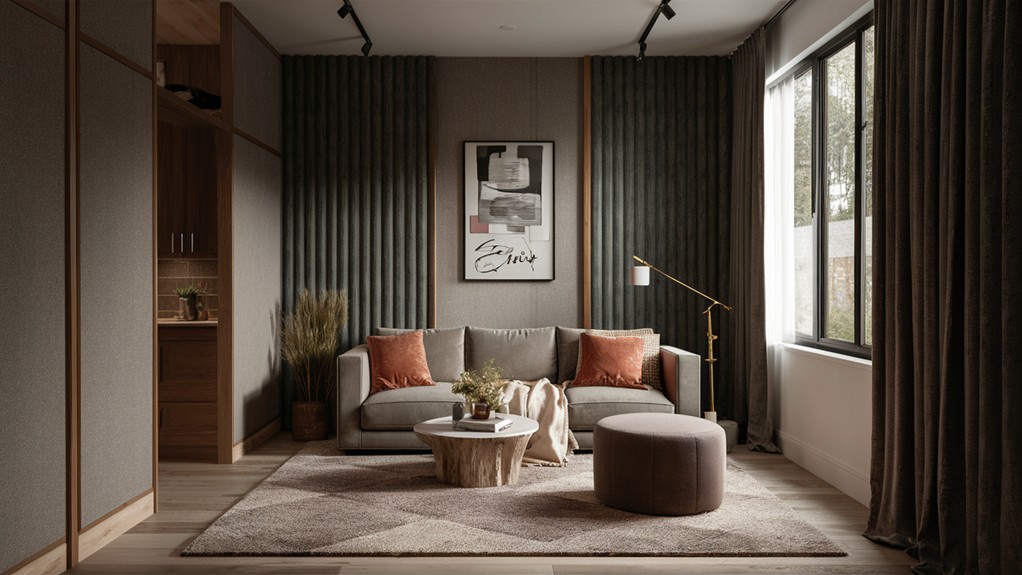To soundproof your training area, start by placing acoustic panels on the walls next to high-traffic zones. Staggered or overlapping panels improve soundproofing, while thicker foam or mineral wool panels absorb low-frequency sounds. Rubber flooring and high-density foam mats can likewise minimize vibrations and impact noise. Insulating walls and ceilings, adding drywall, and sealing gaps around doors and windows will greatly reduce noise transfer. Acoustic improvements like soundproof curtains, tiles, and baffles further refine the acoustics. Plus, adjusting your workout schedule and focusing on quieter movements can keep the noise down. To learn more about creating your ideal training sanctuary, read on.
Acoustic Panel Strategies
If you're looking to soundproof your training area, acoustic panels are a highly effective solution. By strategically placing these panels on your walls, you can notably reduce echoes and reverberation, enhancing speech intelligibility and general sound quality.
When it comes to panel placement, consider covering the areas that generate the most noise, such as walls adjacent to high-traffic zones or corners that can amplify sound. Arranging the panels in a staggered or overlapping pattern can further improve their soundproofing capabilities.
The material selection of your acoustic panels is also vital. Thicker panels made from foam or mineral wool are particularly effective at absorbing low-frequency sounds, which can be especially problematic in training environments.
Combining different types of panels, such as wall-mounted and ceiling baffles, can create a more thorough soundproofing strategy.
Customizable acoustic panels are available in a variety of colors and designs, allowing you to integrate them seamlessly into your training space while maintaining their functional benefits.
Flooring and Underlayment Solutions
Rubber flooring materials are an excellent choice for soundproofing your training area. Designed to absorb sound and minimize vibrations, rubber flooring can considerably reduce impact noise from heavy weights during your workouts. For even greater noise reduction, consider thicker flooring mats made from high-density foam or rubber, as the additional mass and cushioning underfoot will further improve sound absorption.
Another versatile option is interlocking foam tiles. Not only do they offer customizable layouts, but their sound-dampening properties help minimize sound transmission. And don't forget about underlayment! Placing it beneath hard flooring, like laminate or tile, can act as an additional sound barrier, particularly in high-traffic areas.
If you're setting up a treadmill, a dedicated treadmill mat is a must-have. These specialized mats are designed to absorb vibrations and reduce the noise generated from running, helping to maintain a quieter environment in your training space.
| Flooring Option | Noise Reduction Effectiveness | Customization Level |
|---|---|---|
| Rubber Flooring | High | Moderate |
| Foam Tiles | Moderate | High |
| Underlayment | Moderate | High |
| Treadmill Mat | High | Low |
| High-Density Mats | High | Moderate |
Wall and Ceiling Treatments

Insulating your walls and ceilings can considerably reduce noise transfer in your training area.
Adding drywall creates an additional sound barrier, enhancing the overall soundproofing effectiveness.
Acoustic panels strategically placed on the walls and ceilings can minimize echoes and improve acoustics. These panels, made from sound-absorbing materials, catch and absorb sound waves, reducing reverberation in high-ceiling environments.
Soundproofing panels can be mounted directly onto your walls and ceilings, further enhancing sound absorption and providing a visually appealing solution.
Ultimately, heavy drapes or acoustic curtains over your windows can absorb sound waves and prevent leaks around openings, completing your soundproofing efforts.
Sealing Gaps and Cracks
Inspecting your training area for gaps around doors, windows, and walls is crucial, as even small openings can considerably undermine your soundproofing efforts. Seal these areas with weather stripping to create a tight barrier, preventing sound leakage and improving the overall acoustics.
Additionally, consider these strategies:
- Apply caulk to cracks in walls and around fixtures, as this can help block sound from traveling through small openings and boost sound isolation.
- Verify all entry points, including electrical outlets and vents, are properly sealed to minimize sound transmission and elevate the soundproofing integrity of your training space.
- Regularly inspect and maintain seals and caulking to confirm they remain effective over time, as wear and tear can lead to new gaps that allow noise to penetrate.
Acoustic Enhancements

Soundproofing your training area can be further improved through the strategic placement of acoustic improvements.
Soundproof curtains, for instance, can greatly absorb sound waves and reduce noise levels, minimizing distractions during your workouts. Hang these heavy-duty curtains around your training space to create a more focused environment.
Acoustic tiles and panels are likewise highly effective, as you can strategically place them on walls and ceilings to absorb unwanted sounds. This can help create a quieter atmosphere, allowing you to stay centered and perform at your best.
For high-ceiling training spaces, consider installing acoustic baffles suspended from the ceiling. These clever devices capture sound waves and prevent excessive reverberation, effectively decreasing noise levels.
Complement these improvements with soft furnishings, such as upholstered benches or cushions, to further improve acoustic absorption and comfort.
Noise Management Practices
To maintain a considerate training environment, schedule your workouts during reasonable hours to limit disturbances to neighbors and family members. This simple yet effective approach fosters a more respectful training atmosphere for all.
Furthermore, to improve your workout etiquette, consider these communication strategies:
- Communicate with your neighbors about your workout schedule to manage their expectations and reduce potential noise complaints. This open dialogue can help create a harmonious living space.
- Limit high-impact exercises, such as jumping or dropping weights, to minimize noise levels during your training sessions. Modify your routines to emphasize control and quieter movements, such as incorporating bodyweight exercises or resistance bands.
- Be mindful of your family members' schedules and adjust your workout times to avoid conflicts, ensuring a harmonious living environment for all.
Frequently Asked Questions
How Do You Soundproof a Practice Space?
To soundproof your practice space, install acoustic panels on the walls, use soundproof flooring, and seal any gaps around doors and windows. These steps can considerably reduce sound transmission and improve the general sound quality in your space.
How to Soundproof From a Train?
To reduce train noise, use soundproof materials like double-glazed windows, acoustic curtains, and insulation. Seal gaps and install a floating floor to effectively soundproof your space from disruptive train vibrations and noise.
How Do I Soundproof My Workshop?
To soundproof your workshop, use acoustic panels and noise barriers like insulated walls, heavy curtains, and sealed gaps. These materials can reduce noise levels by up to 50% and contain sound within the space.
Do Soundproof Curtains Work for Trains?
Soundproof curtains can effectively reduce noise from passing trains. The dense, heavy fabrics used in these curtains absorb sound waves, providing up to 30% noise reduction when properly installed.
